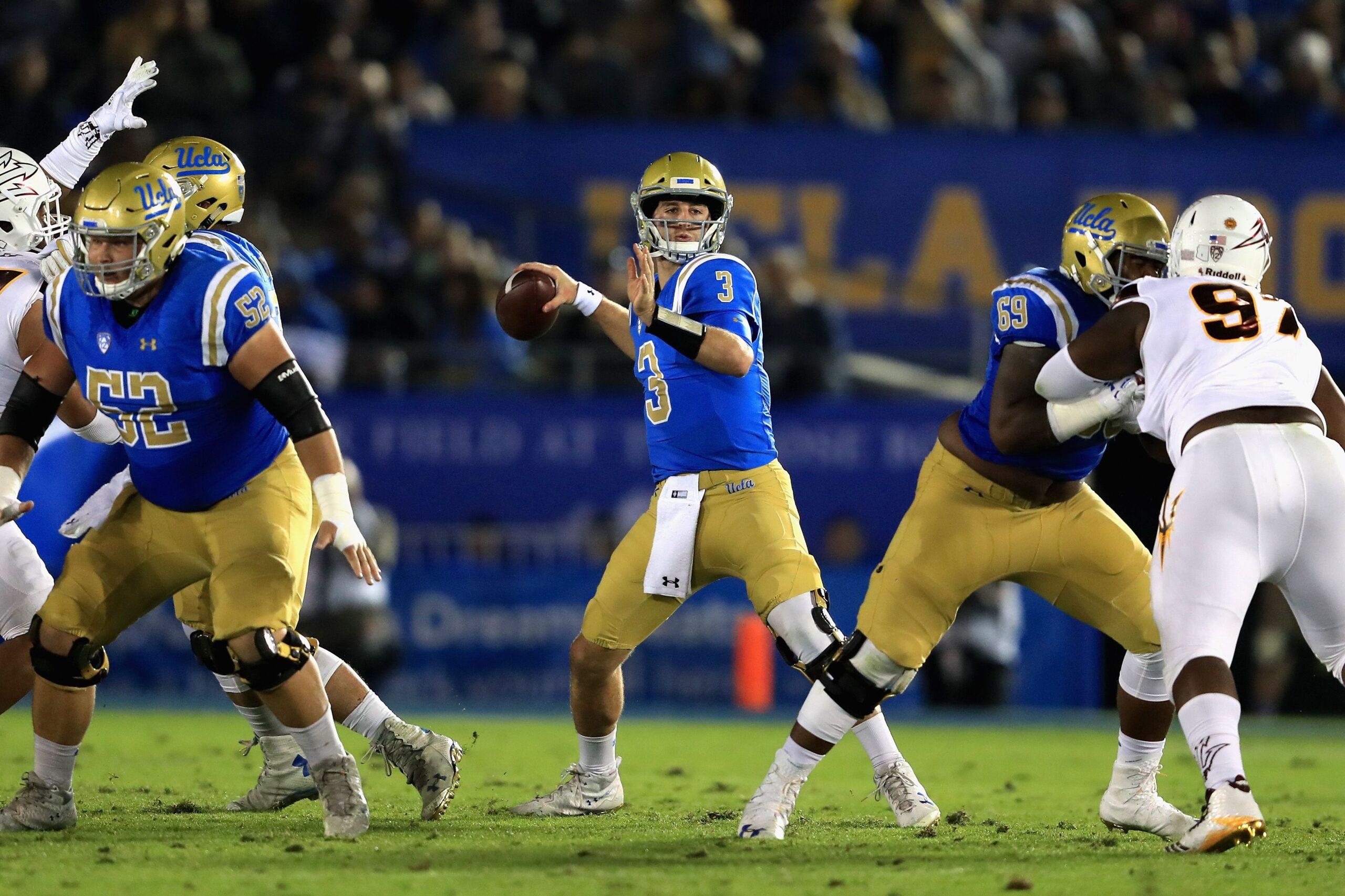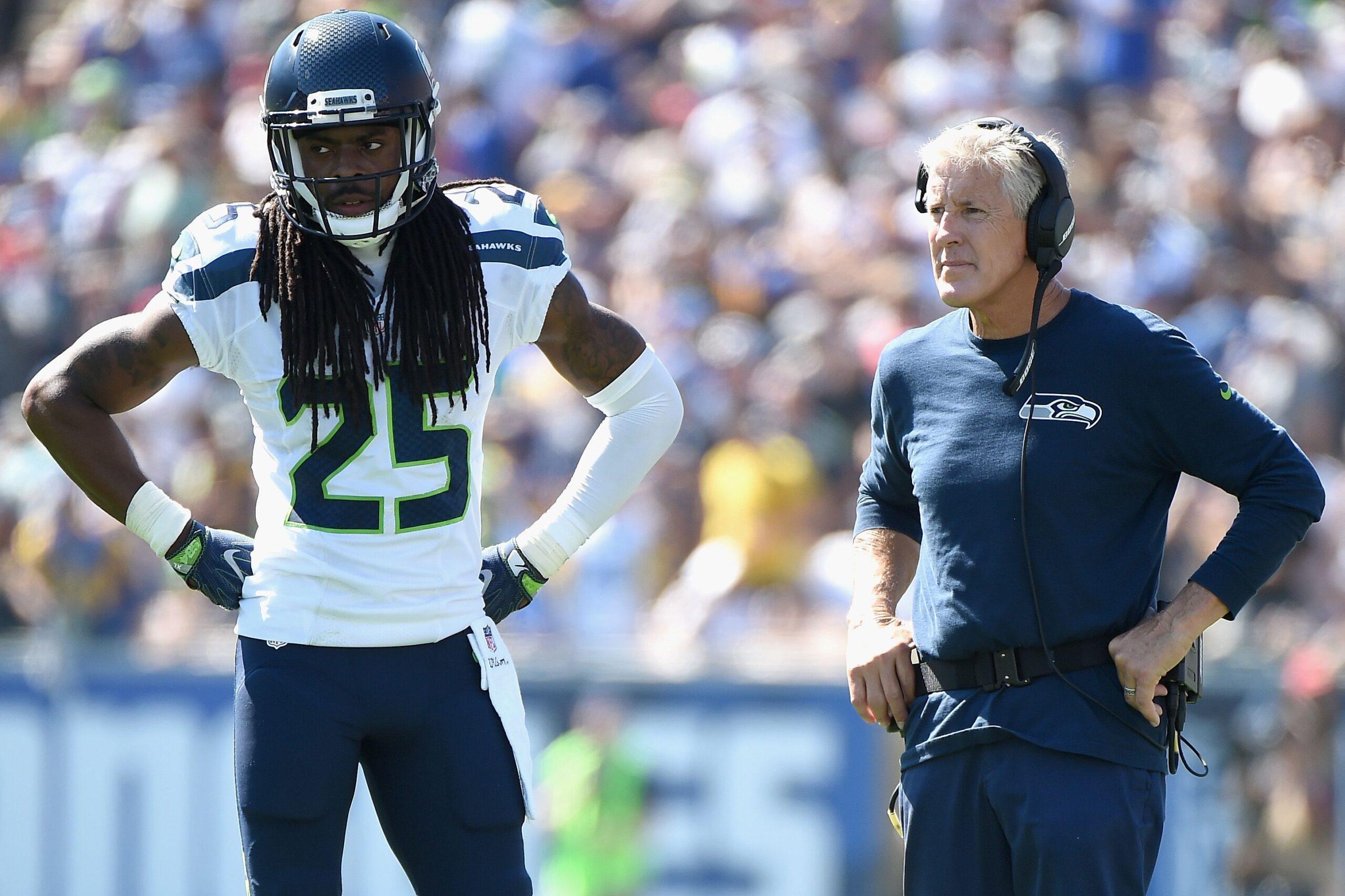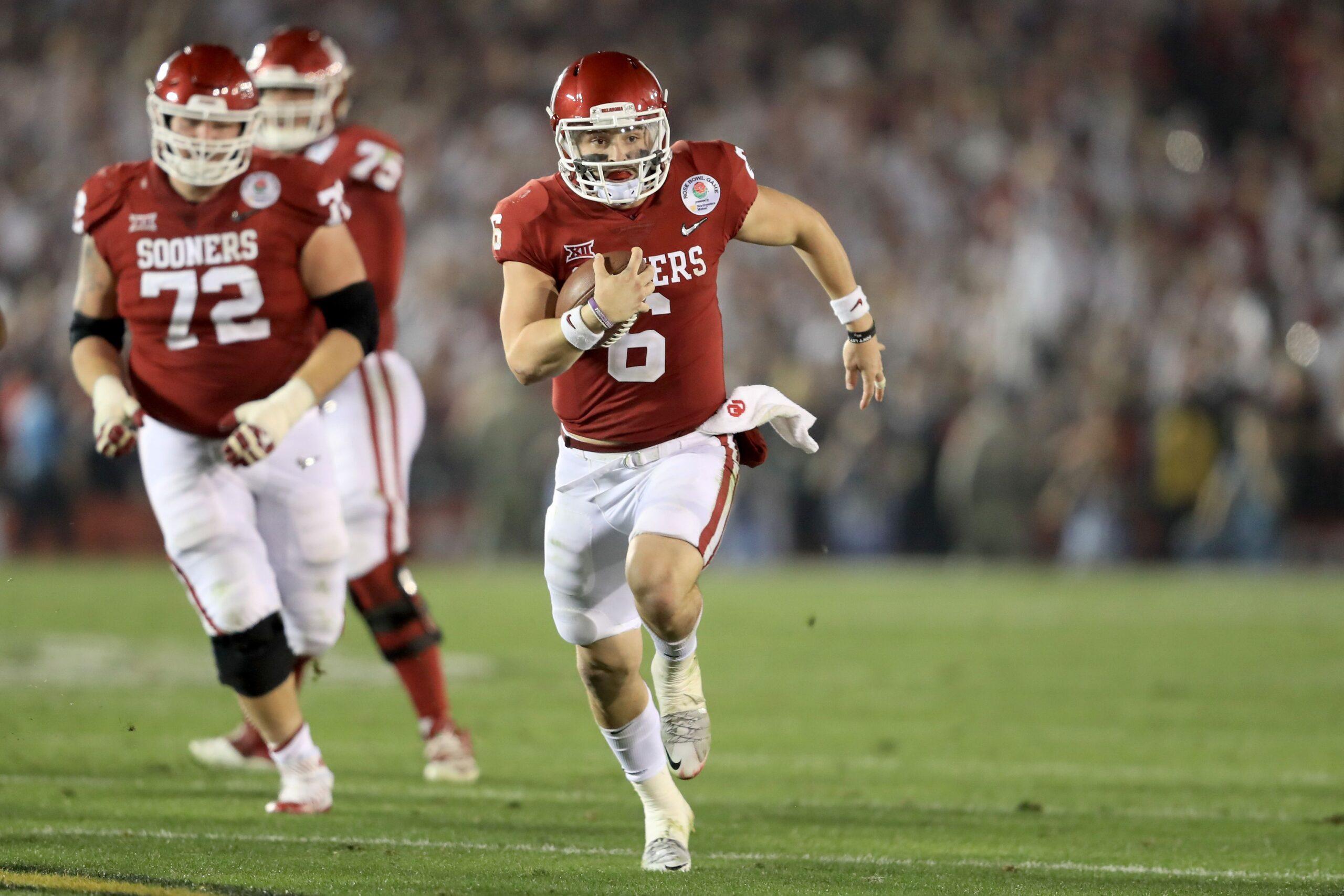(How to) View Grit
NFL scouts spend hundreds of hours every year poring over tape to find an edge in the draft, but there’s one element that’s impossible to measure: intangibles. Here’s how the league’s evaluators try to crack the code for unquantifiable traits like poise, leadership, toughness, confidence, and, yes, grit.From one year to the next, no team consistently fares better than the rest at picking winners in the NFL draft. It’s not unheard of for a franchise to go on a hot streak, landing multiple stars over a couple of offseasons, and there are certainly a few organizations that have proved to be dependably worse than average (sorry, Cleveland). But the draft remains a crapshoot.
That’s because while the old football adage the tape doesn’t lie is catchy, it clearly isn’t always true. Film is just one piece of the scouting puzzle; the rest is centered around, essentially, predicting the future. Scouting departments are tasked with not only projecting how a given prospect’s skill set translates against better competition at the pro level, but often how it will work in an entirely different scheme. On top of that, scouts must determine a player’s capacity for improvement, dig into his mental makeup, assess how he’ll deal with failure (and success), and decide how well he’ll fit into the culture of the locker room. Put simply, the hardest part of a scout’s job isn’t watching tape — it’s evaluating all the intangibles a player brings to the table.
Identifying and grading those hard-to-define traits can “make or break whether a scout is good at their job, and whether or not a team is good at finding players,” Mike McCartney, an an agent and former scout with the Bears and former director of pro personnel with the Eagles, told me. “It’s one person evaluating another person. All people are different, and they change.”
Of course, no one has a time machine, so teams have established methodologies for building psychological profiles — like how hard a player works, how he practices, what he’s like when he’s not on the field, and how much he loves football. It amounts to what’s essentially the NFL’s version of espionage — really! Organizations utilize their established network of assets who can provide to them that much-needed intel. “Scouts who have been going to the same schools year in and year out develop relationships,” said McCartney, “whether it’s on the coaching side, the training room, the equipment room, or in academics.
“But the challenge is, at some schools, if you don’t really have a great relationship, how can you really learn about a player when they’re in their environment?” said McCartney. “Teams typically see players in a sterile environment, where they’re coached up at the combine or an all-star game, and they don’t get into their homes. They don’t get into the way they live on a daily basis. That’s why there’s a premium on experienced scouts who have relationships — I always believe that the NFL is a relationship business — because from a scouting standpoint, if you don’t have good relationships on campus, can you really find out if a player has grit?”
To get the job done, scouts end up wearing any number of hats for their team: that of a tape-evaluator, a spy, or a de facto psychologist.
The art of finding a guy who “tilts the field,” as Seahawks GM John Schneider once put it, makes scouting the quarterback position in particular even more, shall we say, abstract. The roads to both NFL draft heaven and hell are paved with bad clichés: “There’s an ‘it’ factor,” you must look for, said former Packers GM Ted Thompson. For his mentor, legendary Green Bay GM Ron Wolf, “The most important thing is the will to win.”
Unfortunately, both the It Factor and the Will To Win are fickle beasts. The search for the nuanced traits that separate future superstars from the busts often sends evaluators down rabbit holes trying to pinpoint exactly what kind of person is most likely to turn into a Hall of Famer. There’s no established consensus on what traits are needed, and as The Ringer’s Kevin Clark wrote this week, that’s how we’ve gotten to the part of the pre-draft process where UCLA’s Josh Rosen — a millennial quarterback who, according to former coach Jim Mora Jr., must be “challenged intellectually” — ends up getting criticized for having the same personality type as Tom Brady and Aaron Rodgers.

But individual teams will look at certain character traits differently. For some coaches, the idea of a player who asks “why?” might mean they’re uncoachable. For others, intellectual curiosity is considered a plus, particularly at quarterback, a position that straddles the roles of both player and coach. As Clark noted, both Peyton Manning and Rodgers are famous in the league for asking “why?” to every coaching decision. You’d think that level of engagement is something teams would actually, you know, want.
In Bill Walsh’s book The Score Takes Care of Itself, there’s a chapter titled “Welcome Skeptics to Your Team.” In it, Walsh credits his creation of the West Coast offense — a game-changing scheme borne in the late ’60s when the legendary coach was an assistant under Paul Brown in Cincinnati — to both necessity (the team’s starting QB got hurt and left them scrambling to figure out how to use backup Virgil Carter, who struggled throwing deep but excelled on quick, short passes) and to Brown’s uncommon willingness to innovate. But fast-forward 50 years and many teams still seem resistant to any challenge of the status quo, and that stubbornness often bleeds into their evaluations.
“Unfortunately,” Walsh wrote, “too often we find comfort in what worked before — even when it stops working. We get stuck there and resist the new, the unfamiliar, the unconventional.” Does that sound like any teams you know?
Former NFL offensive lineman Geoff Schwartz, who played on five teams over nine seasons in the league, framed the Rosen discussion another way, though, and made an important point. “There are layers it. People might say teams are worried that he’s too smart, but it’s really that they worry he has other interests outside of football. I think that’s what it boils down to, because that really does bother NFL people.” The fear for teams is that those outside interests could start to infringe on the more-than-full-time job of being an NFL quarterback.
“I’m not saying it’s right, but it makes sense,” said Schwartz. “NFL people, all they do is NFL. Coaches love to fucking coach. They coach all day. Offseason, they’re working 12-hour days. In-season, they’re there at six o’clock in the morning and leave at midnight. Scouts are traveling all over the place to scout guys. It’s a nonstop business. So if they feel that a player is not 100 percent committed — I don’t know if Rosen is or isn’t, but I think he is — it’s a turnoff. Quarterback is a different beast. You’re expected to do — and be prepared — a little bit more.”
What it comes down to is assessing what some call a potential franchise quarterback’s football character. Is he going to be at the building when he’s scheduled to be — and even when he isn’t? Is he going to be the guy who sets the standard of work ethic for the whole team, studying tape and doing all the little things to grow and improve? As Dan Hatman, a former pro scout and now director of scouting development at The Scouting Academy, told me, “With Rosen, here’s what I ask: ‘Which parts of playing quarterback are you just born with, and which ones do you have to learn?’ Well, you’ve got to learn footwork, you’ve got to learn mechanics — and sure, your arm slot is a more natural thing, and some guys mentally process things faster — but to learn concepts, to learn coverage, you’ve got to be taught all that. So, we’re going to be concerned about the football character of a guy who, right now, most people consider to be the furthest ahead in most technical pieces to the game? Clearly, he’s dedicated to doing those things; they don’t just fall into place.”
The ability to lead is another frequently cited prerequisite to playing quarterback. But leadership comes in many forms: There are the rousing pregame speech-givers; the strong, silent types who lead by example; or the outgoing charismatics. Whatever the case, as former NFL defensive lineman and SB Nation writer Stephen White told me, “Confidence is the biggest thing for a quarterback. When that guy is playing with confidence, when he looks like he knows what he’s doing, that has such an influence on everybody else.
“Some guys carry themselves like they’re hoping something good happens,” he said. “Other guys carry themselves like they expect to make something good happen. And [with the latter], you really can feel it.”
But confidence, a good speech, an unassailable work ethic, or a natural charisma can only get a quarterback so far. As former Ravens head coach Brian Billick wrote in More Than a Game, a QB needs to make plays. “You can talk about ice water in the veins and unflappability in the huddle,” he wrote. “You can wax eloquent about the steel-blue gaze in Joe Montana’s eyes and the slouchy self-assuredness of [Joe] Namath in his heyday. But in the end, all leadership eventually stems from production. I have known many quarterbacks with the intelligence and charisma to draw people to their leadership who eventually failed because they could not produce on the field. You like them, you wanted to follow them, but the lack of production left you knowing they would lead, but no one would follow.”
That serves as a good reminder that no one intangible trait can ever be enough. Teams must weigh what they think is the right balance between all the identifiable on-field skills with things like poise, leadership, mental toughness, and single-minded passion for the game. When all the stars align and a player with all those attributes finds himself in the right situation with the right coaching, beautiful things can happen.
But teams are still really bad at evaluating and drafting quarterbacks — hell, they might actually be getting worse — and it’s not just because they don’t always know what to look for, it’s because those stars so rarely align. As Billick wrote, each of the modern-era Hall of Fame quarterbacks has possessed “a combination of functional intelligence, athletic ability, arm strength, toughness, and command presence. One Hall of Famer’s mixture of skills varies from that of the next and each mixture is impossible to duplicate. You either have the right, rare winning combination of abilities in the right time and place, or you don’t.”
The Super Bowl–winning former coach referenced an analogy he got from Walsh comparing great quarterbacks to concert pianists: “Any person who knows how to read music and play the piano has the same basic skills as the most accomplished concert pianist. The difference is the truly unique combination of skill, passion, focus, competitiveness, and dedication that separates one from the other.”
“These are the same attributes it takes to play quarterback in the National Football League and the hardest to isolate, identify, and quantify,” writes Billick. “But find me a tough gym rat with a live arm, pinpoint control, and a level head, and I’ll take my chances.”
The search for intangibles doesn’t stop at the quarterback position. In some ways, when scouts go from breaking down the mental makeup of signal-callers to cornerbacks, the evaluation doesn’t really change. “Confidence is really important at a couple of positions: quarterback and cornerback, in particular,” said McCartney. “At both positions, your mistakes are right there for everyone to see. The confident guys are the ones that can overcome [those miscues].”
Past that, at any position, teams are going to want guys with so-called football character.
“There are programs that will ding a guy if he doesn’t display that football character,” said Hatman. “You listen to [Titans GM] Jon Robinson, I genuinely believe that he gives a crap about football character, and he will pass on a player that might be slightly better in a tier to take a guy who’s going to be a better professional football player.”

Evaluators are looking for the guys who will grind, work to get better, and, if you’re talking to Pete Carroll, display that grit — or as Carroll defines it, “persistence and resiliency and an inner strength and belief you can get it done.”
“Football becomes a craft, and these players master it,” said Hatman. “If you listen to Richard Sherman talk football, I think he’s self-aware that he doesn’t have Patrick Peterson’s skill set. He has to be better at the other parts of it to ever be in the same tier from a production standpoint of someone better physically.” Teams value the dependability of those high-football-character guys, said Hatman, and they’ll give up a little bit in the talent department to acquire those players. “You live with that [slight downgrade in talent or upside], because you can design something knowing there will be less variability from your players, you can start to anticipate the outcomes a little better,” he said. “Whenever one of your players is volatile on a given play, that becomes really complicated to scheme for.”
However, not all position groups play the same roles, so when evaluating prospects who are going to be playing in the trenches, the personality traits scouts are looking for are often of a slightly different nature than that of other positions.
“Offensive linemen are out there 60-plus plays a game,” said Hatman. “They’re having to go backward against a better athlete on the other side. The guys who are kind of a prick on the field — they tend to play better and play longer.” Some might refer to that as having an edge. “To be an offensive lineman,” explained Schwartz, “you have to be a little bit … off.”
There’s a fine line to walk there, considering coaches and teammates are going to be spending half the year with that guy in close quarters and stuffy meeting rooms. That’s why finding a player who can easily flip the proverbial switch into game mode can be a priority. “I’ve played with and encountered so many people who have a switch,” said White. “They can be the nicest person off the field, but on the field, that’s when they’re that asshole that you want them to be. Really, that’s the kind of dude teams want: guys that finish, they love that kind of stuff. They want us to be always trying to get the last hit in, always trying to dominate somebody instead of letting somebody dominate us. But off the field, it’s a totally different thing.
“That was the type of most of the guys I played with,” he said. “I knew that on the field, you might go a little bit too far, but off of it, you couldn’t be nicer.”
How do scouts identify some of these traits? Plenty of them trust their “gut” or rely heavily on “instincts.” That may seem like something worth scoffing at — and a lot of the time, it probably should be. But in some cases, it’s tough to discount the value of an experienced and proven evaluator’s eye for subtle nuances. As former Redskins GM Scot McCloughan, a football savant who now owns a consulting company (aptly named Instinctive Scouting), told Bleacher Report, picking players starts with “a gut thing,” and there are times when it takes watching only about 10 or 15 snaps to know that a prospect is worth digging into deeper.
And when it comes to anything more than a player’s apparent physical skills, it often takes intuition to evaluate. “I’ve definitely seen [the concept of] competitiveness scored or graded,” said Hatman. “The question is, how do you teach [a scout to do] that? There was a Supreme Court justice who heard a case on obscenity, and he said, ‘I can’t define pornography for you, ‘but I know it when I see it.’ I lean on that line; I don’t know if we can come up with five or 10 words that will properly capture competitiveness, but when you watch game after game after game, guys differentiate themselves. Baker Mayfield is an objectively competitive player on the field. You watch Quenton Nelson play football — that guy’s objectively competitive. Minkah Fitzpatrick. Derrius Guice. These guys are out there. They’re not backing down.”

That’s easy to see when you watch Nelson choke-slam a blitzer or Guice run through a trio of defenders, but for many other players, these types of traits are not always quite so obvious. That’s where skills in detecting the near-undetectable come into play. In David Eagleman’s book Incognito: The Secret Lives of the Brain, he broke down a Japanese method for determining the gender of day-old chicken hatchlings (also known as “chicken sexing”; yes, really). Apparently, there’s no real way to explain to someone how to visually determine the difference between the nearly identical genitalia of male and female hatchlings (and per Richard Horsey, a cognitive scientist who studies the process, “If you ask the expert chicken-sexers themselves, they’ll tell you that in many cases they have no idea how they make their decisions”). So the Japanese developed a method wherein a master sexer (wow) would stand with a student, who’d pick up a hatchling, examine its rear, and toss it into one two bins, either male or female. The master would then give a simple “yes” or “no” response. After a few weeks, that student’s brain would somehow become trained to recognize the near-imperceptible differences between the sexes.
Intuition isn’t only useful for chickens. During World War II, the British used a similar technique to teach novice plane-spotters to identify incoming planes as either friend or foe. A handful of aviation enthusiasts were picked to start the program, and when it expanded, they served as the masters. Those experts successfully trained their students to instinctively separate the British planes from those of the Germans with that same “yes” or “no” tack. To that point, no amount of verbal explanation had worked.
For experienced evaluators, this unconscious trial-and-error method of learning can apply to scouting the intangible strengths and weaknesses of draft prospects. But it may take a lot longer to develop — there’s no quick “yes” or “no” answer as to whether you’re right or wrong on a player — and most teams won’t know whether a prospect is a hit or miss until years down the road. Plus, with so many variables at play, it’s nearly impossible to isolate the real masters from the students.
All that noise is exactly what makes scouting the draft such an imperfect process. Evaluators are tasked with not only interpreting the tape but accounting for a player’s personality, mental makeup, toughness, competitiveness, and everything in between. Plus, as McCartney said, “Every team is different, and everyone who’s evaluating has different things that they value. Some scouts may value toughness. Others may value intelligence. Another one might value speed above all else. A fourth might value grit. Everyone has their own traits that they’re looking for.”
That’s where a well-defined plan and clear lines of communication from decision-makers to coaches and scouts can be key. “What’s incumbent upon the general manager is to make sure the team defines which traits, both on and off the field, they’re looking for,” said McCartney. “The better teams do a good job of bringing all their evaluators into that decision-making process and getting onto the same page.” To that end, continuity at the top certainly helps, but in a league where coaches and front-office executives are constantly on the move and most franchises lack much patience, that continuity is rare.
There’s an incredible amount of skill that goes into the process of scouting, and some general managers and scouts have more talent than others in the art of evaluating tape, so no one’s suggesting that teams should just give up on it and start throwing darts instead. But the human factor at play makes any semblance of consistency exceedingly hard to achieve. The unpredictable nature of how prospects are going to react at the next level means that for teams that want to strengthen their odds for picking winners in the draft, the most important strategy might be to simply make a lot of picks.


